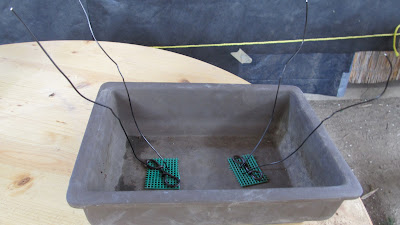Hello everyone welcome to the newest entry in my blog. Today we are going to start with the initial work of a long term project on a large juniper. Its a Chinese Juniper but I'm not sure of the exact cultivar. Its probably about 35-40 years old and there is no telling when the last time it was transplanted.
I did a favor for a friend that owns a nursery that just rents plants for the movie business. We were walking past this tree when he asked how much he owed me, and I said I'll take that and he agreed. So here is what I came home with.
It's kind of hard to tell how big it really is , so here it is again with me to give it some scale.
Like I said a large juniper, 58" wide and 49" tall!
I spent the next hour just looking at the tree from various angles, moving branches around and trying to envision the future of this tree.
Before I get too far into the design of the future bonsai I need to insure that the tree is healthy.
Without even taking it out of the pot I know its totally root bound so some major root work is in store. I also know that I'm going to have to remove a lot of foliage to balance out the amount of rootball I'll need to remove.
I'll start by cutting away branches that I know I won't need in the future, also I want to open up the interior of the tree at the same time. Doing this will allow more air and light to the inside branches of the tree which will encourage new growth towards the interior of the tree. This in turn will allow me to shorten branches later on and still have good strong shoots to work with. Like many old trees a lot of the interior shoots have weakened due to lack of air and light.
I started by taking off a branch that was very heavy about halfway up the tree. Doing this has really exposed the trunk line much better.
There is good movement through the whole line of the trunk. Seeing these curves in the trunk is making me think that we may go with a bunjin or literati style tree. This style of tree generally has fairly sparse foliage and the emphasis is placed on the movement in the trunk. There is also a lot of potential for carving of deadwood both for practical ( dealing with reverse taper) and design reasons. It also has a pretty good nebari or root base, especially for a juniper.
After removing about 60% of the foliage I decide thats enough pruning for now the next step is root work.
As I thought the root ball was a mess. It was a solid mass of roots and hard compacted clay soil. When I tried to comb it out with a chop stick it broke. It looks like most of the healthy roots are on the outside of the rootball.
Something told me trying to comb this out even with root hooks was not in the cards. So I decided to make things a little easier and pulled out the reciprocating saw and cut off half or more of the root ball. Even so it took some effort to get through it.
The light brown area in the center is old nursery soil from when the plant was young. This plant was out in the pouring rain for three days and this part right under the trunk is bone dry.
Using a steel root hook and about 6 chop sticks my assistant and I spent over 90 minutes combing out the root ball and removing as much of the old hard clay soil as we could.
I was actually pleasantly surprised when we finished. I had a relatively flat root ball with a good amount of viable roots. We also had a very good nebari that was exposed after removing soil of the upper layers of soil.
Next we potted it up in a large bonsai pot. This pot is much bigger than necessary but it'll help the tree regain its strength much quicker with more room to grow. It will allow vigorous root growth which in turn will support good growth above.
Here is the probable front-I'm 95% sure I wont be keeping the secondary trunk but for now it can stay.
From the other side you can see the area where I removed several large branches that caused a little reverse taper. For now I'll leave it alone and let the tree find its own ways to re-route the sap around the cut areas. Eventually there will be die back on the trunk from these cuts which I will doing some sculpting on.
Here's another look at the nebari and the trunk movement.
I'm excited about where this tree will allow me to take it. I think in the not too distant future this will be a very good bonsai. But thats the future. For now the tree needs to be allowed to recover from all this work.
For the next 3-4 months I'll do nothing more than water and fertilize. In the beginning of the summer I may do a light pruning of the branch ends to direct the strength into more of the inner foliage. For now I need to be patient. If the tree is growing strongly this summer, we may do some carving, but probably that'll wait until next year. I'm in no rush, I intend to enjoy the process.
Thanks for reading my blog. I hope you found todays post enjoyable and educational. Please feel free to comment.















































